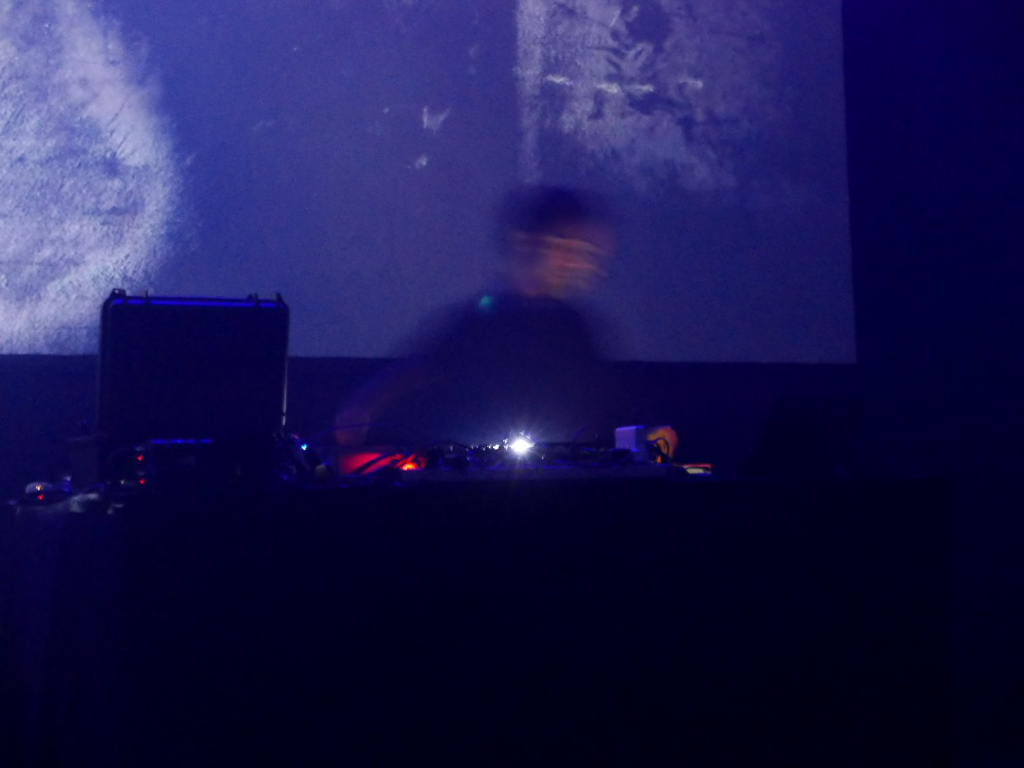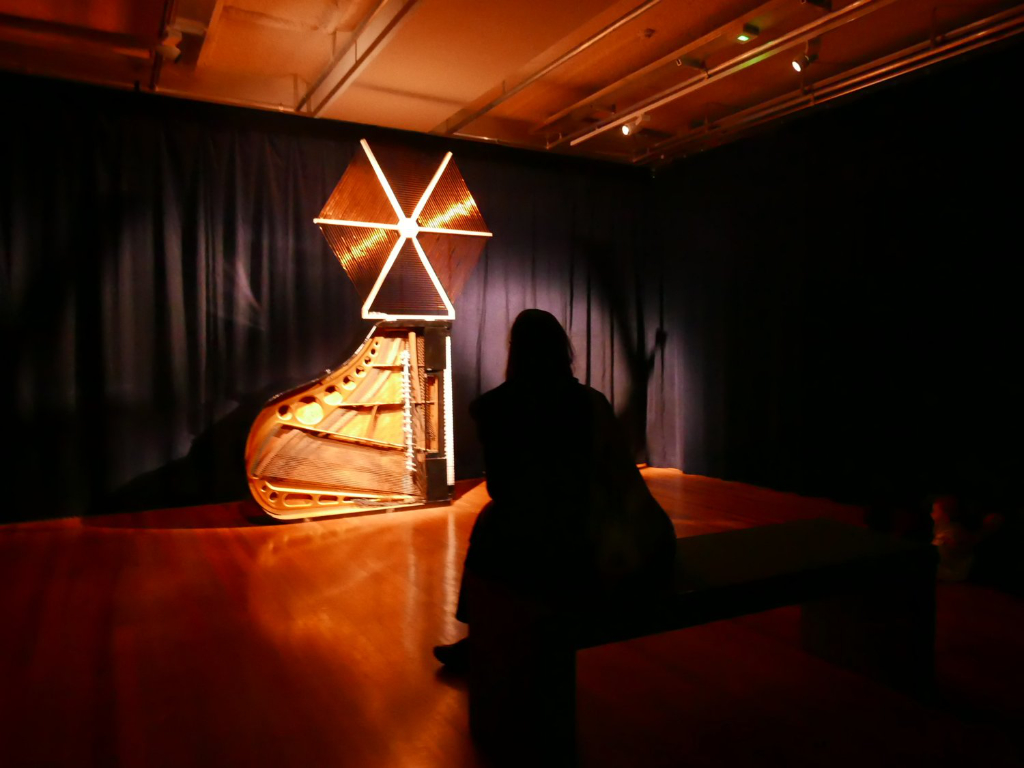Text by Katažyna Jankovska

Organ bodies, slimy creatures, overspill and unbounded, leaving voices as traces of human presence. Dissociated bodies, raving bodies, extended beings, collective entities with pulsating organs and porous skin. Quantum bodies, spectral bodies, temporal beings. Boundless flesh with interconnected pulses and invisible boundaries with permeable skin.
The FIBER Festival returned for its 9th edition with the evocative theme Outer/body, exploring the range of its forms. This theme threads through the festival’s evolving narrative—from the “Instability” in 2020 to exploring notions of mutation in 2021 and 2022, fragmentation last year, and, ultimately, the boundaries between bodies and environments. The continuity of thought and different themes coming back in different forms create the dialogue between the festival’s past, present, and future iterations.
The curatorial framework of the festival looked into the interconnectedness of all life forms, highlighting the porous nature of our existence. We are not impenetrable entities but fluid organisms, connected and extended through spaces and networks technologically and ecologically. As artist Sissel Marie Tonn (whose work Sentinel Self was a part of the OUTER/BODY exhibition) asks, where do we perceive our bodies to end and the environment to begin? This question emphasises our inter-species interdependence within our bodies—encompassing viral, bacterial, and fungal symbionts—and on a planetary scale [1].
The first weekend of June in Amsterdam is full of cultural offerings. Coinciding with Amsterdam Art Week, where over 100 galleries open their doors, and music festivals taking place in other major cities nationwide, competition for attention was fierce. Yet, the FIBER Festival’s seats were filled with their faithful audience and curious newcomers. As people returned each day, exchanging nods and smiles, there was a palpable sense of belonging to a larger collective body.
The festival took place in familiar venues like the Flemish Cultural Centre Brakke Grond, which hosted the context and performance programs as well as an exhibition, and Door Open Space, which hosted a second exhibition. Hosting the majority of the program at Brakke Grond fostered a strong sense of connection among festival-goers. What FIBER does well is indeed weaving individuals into a broader community, where one can quite literally find themselves entangled with other bodies.


A new venue, Orgelpark, added a fresh dimension to the festival. The opening concert on Wednesday night at Orgelpark, a beautiful former church turned concert hall, set the tone for the festival. FIBER presented two premieres crafted specifically for Orgelpark, blending organ sounds, software, and electronic music. Casimir Geelhoed used the hyperorgan, electronics, self-developed software and spatial sound. Maria w Horn and Mats Erlandsson presented a version of The Spectral Organ, adapted to the organs and architecture of the Orgelpark. The light scenography by Zalán Szakács and the Orgelpark’s interior architecture created a mesmerising and mysterious atmosphere.
Friday began with a morning meditation session led by Lou Drago, emphasising the healing potential of sound and the necessity of collective experiences. Drago’s later talk elaborated on creating temporary spaces for resistance, escape, and personal care, exploring how embodied practices and sound contribute to these collective healing spaces.
This year’s context program on Friday and Saturday brought diverse voices and topics. It was incredibly inspiring to hear speakers such as Mckenzie Wark. She performed the extract from her book Raving and talked about the body and rave, the state of dissociation and nonlabor that happens at raves when bodies make useless energy. In her words, a rave is a good place to discover boundaries while being proximate to other bodies. The physicality of it, how bodies are in relation to each other and form a united body of people that is moving.
Diana Alina Serbanescu, aka Neranti, started her talk by asking where the individual body and the collective body begin. How can theatre teach the embodied intelligence to the AI? Libby Heaney’s remote presentation introduced her research on quantum computing. She explained that while we see objects as bounded and fixed, in quantum computing, everything moves towards being more fluid, nonlocal, and nonbinary. Miha Turšič discussed bodies in outer space, emphasizing that one can never be a biological body in such an environment. Technological prostheses are not external but internal because we depend on them. In outer space, we are rovers and voyagers, not biological entities. Human bodies in outer space are merely labourers performing tasks that machines cannot, devoid of identities.


During the festival, two exhibitions were open to visitors: OUTER/BODY at Door Open Space, a 3000m² warehouse north of Amsterdam, and Neighbouring Frequencies at Brakke Grond. Another art installation was presented in the former Slotervaart hospital – the Dutch premiere of Stefanie Egedy‘s Bodies and Subwoofers (B.A.S), which explores the possibilities of low-frequency sound and its impact on bodies. The artist asks: can low-frequency sound create feelings of relaxation and stress reduction?
Saturday’s program ended north of Amsterdam with the Tens:ding performance by Bjarte Wildeman at Door Open Space. Inspired by queer experiences of morphing, adapting, and opening oneself, two suspended performers were moving together, transforming the installation’s shape, balancing between power, fragility, and care, leaving the audience with a feeling of unease and relief.
The club night took place at Garage Noord. The lineup brought some known local names like DJ Shahmaran and DJ Leoni and some international ones like Poly Chain.
The festival’s final day showcased talents from Belgium and the Netherlands, with five performances highlighting innovative uses of sound and movement. Amos Peled’s Phantom Limb used medical imaging to explore the inner workings of the body. During the performance, Peled revisited memories of time spent in healthcare centers, exploring themes like the distance between the body and self, the hierarchy of inside versus outside, pain as a poetic expression, and internal asymmetry. Suzan Peeters’ performance transformed her accordion into a dynamic speaker. Central to her performance was a massage board that caused her body and the accordion to vibrate and oscillate. The sound closely mirrored the movement of the bellows, creating a harmonious interplay between sound and movement.
The festival ended with Myra-Ida van der Veen’s breath-centered performance, “Second Breath.” Inspired by the frog body, the inflatable vibrated as the performers sang, creating the sensation of holding one’s breath, extending the lungs, and transforming the body.
It is always great to return to the FIBER Festival. This multifaceted program left people inspired and curious about next year’s 10th edition. Having left, we remain intertwined as the boundaries of our bodies dissolve into a collective entity.





